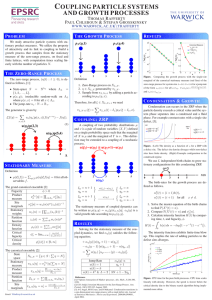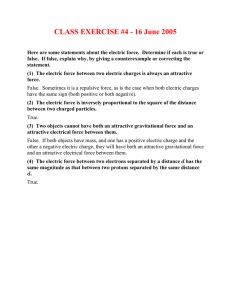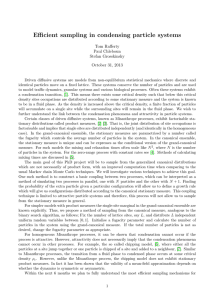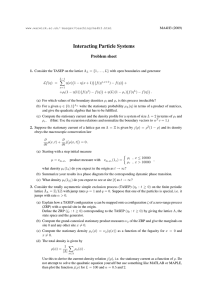Condensation and Attractive Particle Systems Tom Rafferty Paul Chleboun Stefan Grosskinsky
advertisement
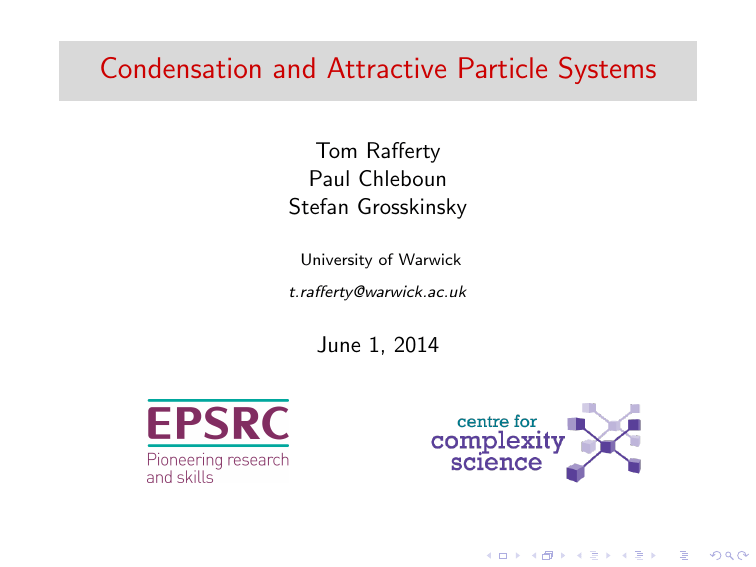
Condensation and Attractive Particle Systems
Tom Rafferty
Paul Chleboun
Stefan Grosskinsky
University of Warwick
t.rafferty@warwick.ac.uk
June 1, 2014
Overview
1 Introduction
2 Condensation
3 The Zero-Range Process
4 The Chipping Model
5 The Chipping Model L=2
6 Attractive Particle Systems
7 Monotonicity
8 What we can prove
9 What we want to prove
10 Conclusion
Introduction
Condensation
Particle Number
100
80
Condensate
60
40
Fluid Phase
20
0
0
200
400
600
800
L
1000
The Zero-Range Process
Definition [Spitzer, 1970]
• A particle leaves a site at rate u(k).
• p(x, y ) corresponds to a random walk.
• Stationary distributions are conditional product measures.
[Andjel, 1982]
uHΗ2LpH2,3L
uHΗ5LpH5,4L
1
2
3
4
5
L
The Chipping Model
Definition [Majumdar et al., 2000]
• A particle leaves a site at rate w .
• Blocks jump at rate 1.
• Stationary distributions are not conditional product measures.
• Prediction for background density ρBG (w ) =
√
1 + w − 1.
w
w
1
1
2
3
4
5
L
The Chipping Model L = 2
2 sites
• Random walk with resetting.
• Can find stationary distribution.
√
• Prediction for background density, ρBG (w ) =
w
0
1
1
1+2w −1
.
2
w
2
3
4
5
1
N-1
N
Attractive Particle Systems
General Idea
d
• For increasing f : S → R we have dt
E(f (η(t))) > 0.
• To prove the processes is attractive we construct a coupling.
• Construct new process which simultaneously simulates a
process with N and N + 1 particles.
uHΞ2L-uHΗ2L º uHΗ2+1L-uHΗ2L
1
2
3
uHΗ2L
4
5
Monotonicity: Example Chipping Model
ΡBG
0.6
0.5
0.4
0.3
0.2
0.1
Ρ
10
20
30
40
50
max
Figure: Measuring the average background density ρBG = h N−η
L−1 i as a
function of density for a two site chipping process. We compare
simulation results against the predicted background density for
w ∈ {1, 1.5, 2}.
Monotonicity: Example Zero-Range Process
ΡBG
0.5
0.4
0.3
0.2
0.1
Ρ
1
2
3
4
max
Figure: Measuring the average background density ρBG = h N−η
L−1 i as a
function of density for a condensing zero-range process. The jump-rate is
given by u(k) = 1 + kb .
What we can prove
Condensation
• Condensation does not occur in the attractive Zero-Range
g (k) ≤ g (k + 1).
Process.
Why?
• We need z(φ) =
• w (n) =
P∞
n=0 w (n)φ
n
to converge at φc < ∞.
Qn
1
k=1 u(k) .
(
∞ unbounded rates
1
• φc = limn→∞ g (n)
=
C bounded rates
−n
−n
• g (1)
≥ w (n) ≥ C
P
P∞
−n φn =
• =⇒ z(φc ) ≥ ∞
c
n=0 C
n=0 1 = ∞.
.
What we want to prove
Assumptions
• Given an ergodic Markov process which conserves the number
of particles.
• The process converges to a stationary conditional product
measure of the form πL,N (η) =
QL
x=1 w (ηx )
−1
ZL,N
.
Statement
• For any conditional product measure we can construct a ZRP
g (n) :=
w (n−1)
w (n) .
• If πL,N ≤ πL,N+1 ⇐⇒ Corresponding ZRP is attractive.
What this implies
• Processes that converge to ordered conditional product
measures don’t exhibit condensation.
How to prove
ZRP attractive =⇒ πL,N ≤ πL,N+1
• Construct a coupling.
πL,N ≤ πL,N+1 =⇒ ZRP attractive
• πL,N ≤ πL,N+1 means f increasing EπL,N (f ) ≤ EπL,N+1 (f ).
• Assume ZRP is not attractive =⇒ ∃K ∈ N such that
g (K ) > g (K + 1).
• Find an increasing function f such that πL,N (f ) > πL,N+1 (f ).
Conclusion
Conclusion
• There exists an attractive particle system that condenses.
• Difficult to analyse since stationary measure is unknown.
• Restricting to two sites the process is a random walk with
resetting.
• Potentially have a general statement concerning conditional
product measures and condensation.
And finally..
• Thanks to my supervisors, Paul and Stefan.
• Any questions??
References
Andjel, E. D. (1982).
Invariant Measures for the Zero Range Process.
Ann. Probab., 10(3):525–547.
Majumdar, S. N., Krishnamurthy, S., and Barma, M. (2000).
Nonequilibrium Phase Transition in a Model of Diffusion ,
Aggregation , and Fragmentation.
pages 1–29.
Spitzer, F. (1970).
Interaction of Markov processes.
Adv. Math., 5:246–290.
